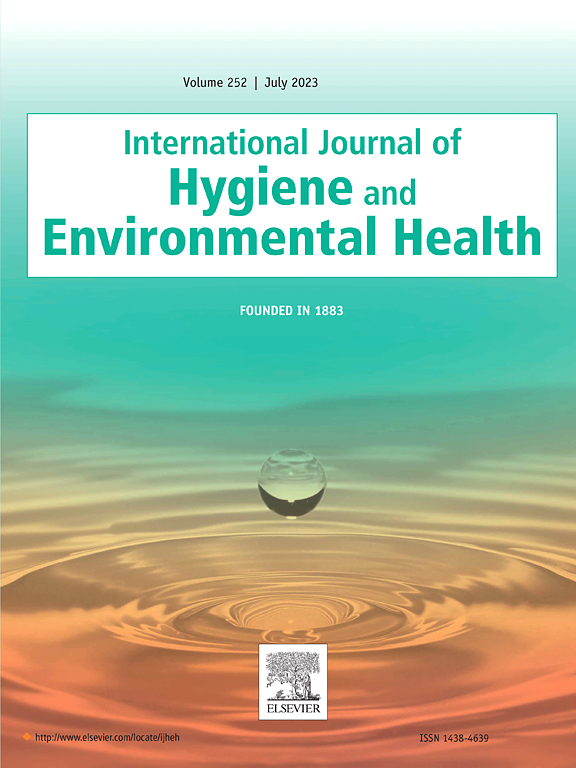Association between ambient temperature and couple fecundity: Insights from a large-scale cohort study in Yunnan, China
IF 4.5
2区 医学
Q1 INFECTIOUS DISEASES
International journal of hygiene and environmental health
Pub Date : 2025-01-27
DOI:10.1016/j.ijheh.2025.114525
引用次数: 0
Abstract
Background
Direct evidence linking ambient temperature to human fecundity is sparse. We aimed to evaluate the potential impact of ambient temperature on time to pregnancy (TTP) and identify the optimal temperature range for initiating conception attempts.
Methods
Our analysis included 576 927 couples from the Chinese National Free Preconception Health Examination Project (NFPHEP) in Yunnan Province, with a one-year follow-up post-enrollment. Each female partner's cycle-specific average temperatures (Tmean) at the couple residences were aggregated and summarized by daily concentrations with a resolution of 0.1° × 0.1°. We used discrete-time Cox regression nested with distributed lag non-linear models to estimate the fecundity odds ratio (FOR) for Tmean concerning one-, two-, or three-cycle preceding pregnancy attempts.
Results
Among the 576 927 couples (mean [SD] age: female partner, 27.6 [5.5] years; male partner, 30.1 [5.8] years), 193 710 couples conceived within 12 cycles, among which 52.1% were pregnant within 3 TTPs and 78.9% were pregnant within 6 TTPs. The cumulative pregnancy rate in 12 menstrual cycles was 38.87%. An inverted U-shaped exposure-response relationship between TTP and Tmean was identified for the cycles preceding the pregnancy attempt. The optimal temperature interval (TI) for conception attempts was determined to be 7.9 °C to 14.5 °C, correlating with a 0.3% (FOR: 1.003, 95%CI: 0.987–1.020) to 3.8% (FOR:1.038, 95%CI: 1.031–1.047) increase in fecundity, compared to the median Tmean of 15.9 °C. Temperatures below or above this interval were linked to a significant reduction in fecundity, ranging from 1.2% (FOR: 0.988, 95%CI: 0.977–1.000) to 6.8% (FOR: 0.932, 95%CI: 0.910–0.953) for the lower TI (<7.9 °C), 2.3% (FOR: 0.977, 95%CI: 0.970–0.984) to 6.6% (FOR: 0.934, 95%CI: 0.921–0.948) for the higher TI (14.5 °C–24.6 °C), respectively, compared to the optimal TI. These findings were robust after stratifying by age and BMI of female or male partners.
Conclusion
Exposure to temperatures within the 7.9 °C to 14.5 °C, one to three menstrual cycles preceding pregnancy attempts, was associated with enhanced fecundity and a reduced TTP, suggesting that the optimal ambient temperature could be pivotal for conception success.
环境温度与配偶繁殖力的关系:来自中国云南大规模队列研究的见解。
背景:将环境温度与人类繁殖力联系起来的直接证据很少。我们旨在评估环境温度对妊娠时间(TTP)的潜在影响,并确定启动受孕尝试的最佳温度范围。方法:我们分析了来自云南省的中国国家免费孕前健康检查项目(NFPHEP)的576 927对夫妇,并在入组后进行了为期一年的随访。每个女性伴侣在夫妇住所的周期特定平均温度(Tmean)按日浓度进行汇总和总结,分辨率为0.1°× 0.1°。我们使用离散时间Cox回归嵌套分布滞后非线性模型来估计Tmean在怀孕前一个、两个或三个周期的生育优势比(FOR)。结果:576 927对夫妇(平均[SD]年龄:女性,27.6[5.5]岁;男性伴侣,30.1[5.8]岁),12个周期内怀孕的夫妇19710对,其中52.1%的夫妇在3个TTPs内怀孕,78.9%的夫妇在6个TTPs内怀孕。12个月经周期累计妊娠率为38.87%。在尝试怀孕前的周期中,TTP和Tmean之间存在倒u型暴露-反应关系。受孕尝试的最佳温度间隔(TI)确定为7.9°C至14.5°C,与中位温度15.9°C相比,繁殖力增加0.3% (for: 1.003, 95%CI: 0.987-1.020)至3.8% (for:1.038, 95%CI: 1.031-1.047)。温度低于或高于这个区间与生育能力的显著降低有关,较低TI的范围从1.2% (FOR: 0.988, 95%CI: 0.977-1.000)到6.8% (FOR: 0.932, 95%CI: 0.910-0.953)(结论:暴露在7.9°C至14.5°C的温度下,怀孕前一到三个月经周期,与生育能力增强和TTP降低有关,这表明最佳环境温度可能是受孕成功的关键。
本文章由计算机程序翻译,如有差异,请以英文原文为准。
求助全文
约1分钟内获得全文
求助全文
来源期刊
CiteScore
11.50
自引率
5.00%
发文量
151
审稿时长
22 days
期刊介绍:
The International Journal of Hygiene and Environmental Health serves as a multidisciplinary forum for original reports on exposure assessment and the reactions to and consequences of human exposure to the biological, chemical, and physical environment. Research reports, short communications, reviews, scientific comments, technical notes, and editorials will be peer-reviewed before acceptance for publication. Priority will be given to articles on epidemiological aspects of environmental toxicology, health risk assessments, susceptible (sub) populations, sanitation and clean water, human biomonitoring, environmental medicine, and public health aspects of exposure-related outcomes.

 求助内容:
求助内容: 应助结果提醒方式:
应助结果提醒方式:


